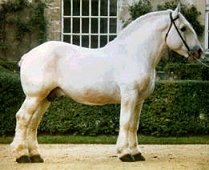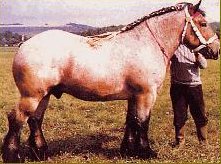
Origin: Northwestern France, in the departments of Oise, Somme, and Pas-de-Calais.
Color: Usually gray (from a very white gray to a strongly dappled iron gray), often dappled, with brown, bay or chestnut occurring occasionally. Chestnuts and bays were once much sought after.
Avg Height: 15.1 to 15.3 hh and 15.3 to 16.3 hh
Avg Weight: 1,210 to 1,430 lbs and 1,430 to 1,650 lbs
Build: This breed possesses a fine, silky coat, a small Arabic-type head set on a thick, arched neck, a broad chest, a straight back with short loins and powerful quarters, and clean, sturdy legs with no feather.
Temperament: Very flexible nature.
Main use: There are two types with the heavier type being used for heavy haulage and in agriculture. The lighter type is a lively, active animal formerly much used for pulling tradesmen's carts.
Special abilities: Energetic and lively draft horse which is strong and has good endurance. Exceptional action for a draft horse- straight, very quick and energetic, with long strides. Has stamina and is able to maintain a steady speed over long periods of time.
History: This breed is regarded as one of the most elegant of the heavy draft breeds. Although of different descent, it is remarkably like the Percheron and similarly has a considerable amount of eastern blood. This is thought to have been derived from Roman cavalry horses taken to France immediately before the invasion of Britain, in the first century A.D., and later, from stock brought back from the Middle East by the French crusaders, when finer Arab and Barb influences were introduced to produce a lighter horse. But the heavy medieval armor meant that size was still important. World War I seriously depleted the number of Boulonnais horses because their primary breeding grounds were right in the heart of the battle zone. World War II also had a second serious impact on the breed, just as it was recovering from the first World War. There are two types of this breed, a large heavy version for use in agriculture and industry and a smaller lighter horse suitable for less strenuous work on small holdings. However the lighter type, very lively and active, is fast disappearing. This lighter version was known as Mareeur or mareyeur (fish merchant) because it was used for the transportation of fish from Normandy to Paris. The exceptional taste and refinement of the meat has most probably saved this breed from vanishing all together.

For Breeders, Farms, and Studs of this breed, click here.
If you have a horse of this breed, and you would like to see your pictures posted here, or if you would like to advertise your business that involves this particular breed, you can also email me.
I'm not perfect, and I never claim to be! If you see anything here that you believe I am wrong about, please feel free to email me. I might not agree with you, but at least I will listen!! :0) Can you fill in any of my blanks? Do you know of information or links that you would like to share with draft animal enthusiasts that you don't see here? Am I missing anything? Let me know at Draftladyb@yahoo.com.